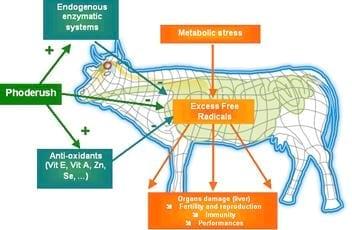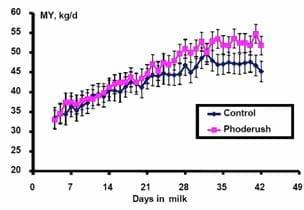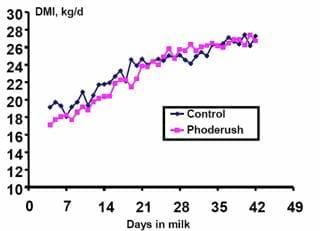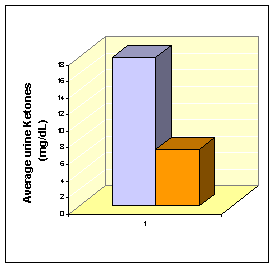Optimizing physiological potential in early lactation
Genetic progresses combined to improved nutritional management have increased performances.
For example, in Wisconsin, the average milk production per cow has increased by 21% between 1991 and 1999, from under 14,000 pounds per year to 17,246 pounds, and is still increasing to a slower but steady pace of around 2%/year (source: Program on Agricultural Technology Studies, University of Wisconsin-Madison; 2004).
Increased productivity puts extra pressure on the animals' metabolism and health, especially during stressful periods of their life cycle. For example, the peri-partum phase, with the establishment of lactation is a very critical point for the cow metabolism and health: immunity and appetite are lower, and metabolic troubles frequent, such as ketosis, which shows a higher prevalence among high producers.
Calving and early lactation are at the cornerstone of the whole milk production campaign and the cow next cycle. Therefore, today's nutritionists and dairy herds managers must be even more careful to adapt the diet to the needs of the early lactating cows and optimize the energy balance, but also to optimize herds management and environment in order to limit additional stress factors, maximize feed intake and the cow digestive physiology.
Phoderush® is a natural blend of feed additives that has been designed by nutrition and olfaction experts of French company Phodé, to optimize the physiological potential of highly productive farm animal. The aromatic core of Phoderush®, aimed to stimulate feed intake, has been successfully tested on farms in Europe. We are now reporting a recent trial assessing its benefits on the metabolism and milk production of early lactating Holstein. This trial shows that the cows were in a better metabolic status when they received the additive after calving, and the subsequent milk production was improved.
An innovative formulation
Phoderush® is a blend of natural plant extracts that has been specially developed to optimize the physiological potential of highly productive farm animals during critical and stressful points of their life cycle, such as parturition and early lactation, but also feed transition, transportation and pen changes, heat stress, weaning, gestation... It comprises three types of specially selected elements:
- Selected spices, shown to strengthen the body's antioxidative defenses and increase feed efficiency by improving the physiology of digestion (stimulation of saliva production, pancreatic enzymes activity, biliary secretions, gastric and intestinal motility, and increased mucosa permeability for nutrients absorption).
- A specific aromatic core, destined to stimulate the animal appetite and increase voluntary feed intake.
- A natural energy supply with high metabolic yield, to compensate for the loss of appetite associated to stress at times of high energy requirement. Its role is to preserve the animal's body resources and liver function.
More specifically, these three components are well adapted to the needs of lactating dairy cows:
1. Stresses have a negative impact on cows appetite and feed intake. Phoderush® aromatic core stimulates oropharyngeal receptors directly linked to the appetite center.
Moreover, attractive ingredients stimulate voluntary feed intake.
The dairy cows appetite and feed intake can thus be optimized during these stress periods. These effects have been demonstrated in field trials across Europe: Phoderush® aromatic core was tested on four farms, involving 410 cows in total, during mid lactation (around 150 days).
In each trial, feed intake increased with time and, as a consequence, milk yield was increased by 1.7 kg/d on average (Figure 1). 
Fig 1: Effect of Phoderush aromatic core on dairy cows daily feed intake (mean of 4 trials, 410 cows).
2. Around calving, with the onset of lactation, the energetic needs of a dairy cows are greatly increased, while feed intake is still low. As a result, the cow energy balance is always negative, leading to body fat utilization and liver neoglucogenesis. To limit the disastrous metabolic consequences usually linked to parturition and early lactation, Phoderush® provides a concentrate of energy: 1 kg of Phoderush® brings 2,600 kcal (natural energy supply).
3. Last but not least, early lactation is typically a period of high oxidative stress for the cow. At cell level, oxidative stress (the excess of free radicals in the organism) results in the damage of the phospholipids constituting the cell membrane, proteins or DNA, with consequences on major cells functions, their proliferation or death. In dairy cows, oxidative stress can lead to alterations of cellular structures, resulting in organs damage, in particular the liver; decreased immunity, resulting in higher risks of placenta retention, mastitis, milk fever, respiratory and digestive diseases; impaired reproductive functions (decrease in fertility, viability and vitality of embryos and offspring...); and loss of performances (decrease in growth rate and milk production, increase of the feed conversion rate). The spices extracts contained in Phoderush® have the unique ability, as shown by in vitro studies, to help restore the oxidative balance by acting at various levels of the body's own anti-oxidative systems (Figure 2):
- They stimulate the activity of the endogenous anti-oxidant enzymatic systems, while inhibiting the pro-oxidant endogenous enzymes.
- They protect the cells against free radicals by scavenging them,
- They protect the cells against lipid peroxidation, which is a main source of cells membrane damages in organs such as liver.
As a result, the animals body defenses, metabolic status and liver integrity are preserved. 
To enlarge the image, click here
Figure 2: Phoderush® proven anti-oxydative effect acts on both arms of the body natural anti-oxydative mechanisms: the anti-oxidant compounds and the anti-oxidants enzymatic systems.
New field evidences: effects of Phoderush® on feed efficacy and metabolic status.
In order to confirm the benefits of Phoderush® formulation for dairy cows, a field trial was conducted between September 2006 and January 2007 in a research station in the US.
A-The trial
Thirty-nine gestating Holstein dairy cows were divided between two groups, equivalent in terms of parity, previous milk production and expected calving date. After calving, the two groups received the same diet (Table 1), supplemented or not (Control) with 250g/cow/day of Phoderush® (Phodé; Albi, France), fed as a topdress, once daily, from the day of calving to week 3 post-calving. The cows were milked twice daily.
Table 1: Percentage of ingredients and chemical composition of the basal lactation TMR fed during the trial.
Ingredient (% of DM) | TMR % |
Corn silage | 26.52 |
Alfalfa haylage | 20.49 |
Ground corn | 19.84 |
Soybeans, cooked | 8.66 |
Liquid molasses | 4.31 |
Cookie meal | 3.88 |
Cottonseed hulls | 3.8 |
Canola meal | 3.75 |
Minerals and vitamins premix | 3.32 |
Alfalfa hay | 3.01 |
Soybeans, heat treated | 2.42 |
| Chemical composition | Means ± SD |
Dry matter, % | 56.56 ± 3.11 |
Crude protein, % of DM | 16.00 ± 0.10 |
NEL, Mcal/kg | 1.62 ± 0.03 |
ADF, % of DM | 24.33 ± 0.98 |
NDF, % of DM | 35.77 ± 3.25 |

B- Increased feed efficacy
Phoderush® treatment had no significant effect on milk yield during the three weeks of supplementation, but, interestingly, the group that received the treatment produced more milk between week 3-6 (+ 4 kg/day, Figure 3), once the lactation was set up. Protein and fat yields were similar between the two groups. This could indicate that Phoderush® is able to optimize the cows metabolism and better prepare it for milk production. 
Figure 3: Effect of Phoderush� additive on dairy cows productivity in early lactation.
Feed intake was also monitored in both groups, showing that Phoderush® improved feed efficacy, increasing the value of feed for the farmer. The return on investment (ROI) could be estimated between 1:3 and 1:5 (Table 2).
Table 2: Effect of Phoderush� on average feed efficacy in early lactation and ROI.
1-3 weeks | 1-6 weeks | |
Effect of Phoderush® on feed efficacy vs control | +11,5% | +10,4% |
Return On Investment | 1:3 | 1:5 |
Moreover, if we consider the day-to-day variations of feed intake, we notice that the treatment had a positive effect on feeding behavior, which is a good indicator of cows status and an important factor of digestive health.
In the first days after calving, when the cows feed intake capacity and/or appetite is down, while their nutritional requirements are greater, it is important that the cows have a regular and sustained feed intake, as observed with Phoderush® (Figure 4), and an optimal feed value.
Figure 4: Evolution of daily dry matter intake in early lactation, showing a "smoothing" effect of Phoderush®.
C- Improved metabolic status
In the same trial, with a view to highlighting the effects of Phoderush® on early lactating cows metabolism, blood metabolites (glucose, β-Hydroxybutyrate- BHBA-, non esterified fatty acids - NEFA-, insulin and urea nitrogen), were analyzed weekly, approximately two hours after morning feeding, and urine ketones were assessed.
The effect of the additive on urine ketones was the most notable: on average, Phoderush® lead to over a 2.5-fold reduction of urine ketones compared to control (P= 0.18), indicating a dramatic reduction in blood ketones (Figure 5).
These results show that, even though the cows in the treated group had a tendency to eat less dry DM, they mobilized less body fat in early lactation than the control cows. This is certainly due to an improved feed utilization and the readily available energy supply brought by the additive. Thus, Phoderush® helped improve the cows metabolic status.
This important effect on urine ketones also points to the potential benefits of Phoderush® in the prevention of ketosis in early lactation. Since ketosis incidence was already low in the experimental groups, it could be interesting to pursue investigations in higher risks animals, in order to assess the efficacy of Phoderush® as a natural alternative for the prevention of ketosis in early lactation.

Fig 5: Effect of Phoderush® on average urine ketones contents.
Overall blood level of β-Hydroxybutyrate, a product of incomplete oxidation of non esterified fatty acids in the liver, was slightly lower (non significant) with Phoderush®. But its variations in time are more informative. In fact, they reflect those of the urine ketones: for the two parameters, both indicators of body fat utilization, there is a significant reduction at day 14 (Table 3), compared to control, while, at day 21, the control group had catch up with the treated group.
These trends enable to advance that, in presence of Phoderush®, the animal metabolism is restored earlier. It seems that the critical period for the cows metabolism (utilization of body fat, deficient energy balance) is shortened by about 1 week with Phoderush®, with positive effect on the rest of the milk production campaign.
These observations are correlated with the blood glucose levels. While overall blood glucose level was not significantly different between the two groups, there was also a noticeable difference at day 14 into lactation (Table 3). Then, both values were equivalent at day 21 (+/-58.7 mg/mL).
Again, it seems that the cows metabolism was restored quicker with Phoderush®. These data are correlated further with the increased milk yield observed after three weeks with the additive. From these data we can conclude that cows receiving Phoderush® responded by better expressing their physiological potential and increasing milk yield.
Table 3: Effect of Phoderush® on dairy cows metabolic status at 14 days.
Control | Phoderush® | P= | |
Urine ketones (mg/dL) | 21.4 | 1.7 | 0.08 |
Blood BHBA (μM) | 1047 | 688 | 0.10 |
Blood glucose (mg/dL) | 57.2 | 54.2 | 0.15 |
There was no effect of the additive on NEFA, also issued from lipids mobilization, but lipids mobilization was higher in the Phoderush® group at time zero, which may be due to a difference between both average live weight, non significant but numerically high. The Phoderush® group cows were on average 31 kg lighter than control before the study. This difference in the two groups at start can also explain that body weight and energy balance were numerically lower in the Phoderush® group, while the feed utilization was improved.
The properties of Phoderush®, a blend of an aromatic core, antioxidative natural extracts and a natural energy source, are well reflected in the various trials: feed intake is either improved or more regular, and feed efficiency is enhanced, certainly resulting from better digestive functions, nutrients absorption and energy supply. The cows metabolism is improved too, with less pressure on the cows body reserves and hepatic function. As a consequence, milk yield is improved after the transition period.
In conclusion, Phoderush® helps high producing dairy cows cope with the metabolic pressure of early lactation, and enables them to express their full physiological potential in a natural way.




United States







